![]()
![]()
![]()
Use LEFT and RIGHT arrow keys to navigate between flashcards;
Use UP and DOWN arrow keys to flip the card;
H to show hint;
A reads text to speech;
43 Cards in this Set
- Front
- Back
|
Three major types of muscle tissues: Skeletal muscle
|
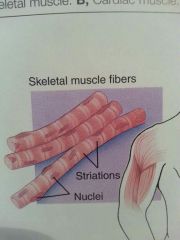
Also called striated or voluntary muscle
Is 40% to 50% of body weight (red meat attached to the bone) Microscope reveals crosswise stripes or striations, appear in bundles with multiple nuclei, cylindrical threadlike cells Contractions can be voluntarily controlled |
|
|
Three major types of muscle tissues: Cardiac muscle
|
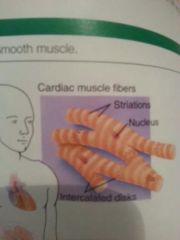
Composes bulk of heart
Cells are cylindrical, branch frequently and then recombine into a continuous mass of interconnected tissue, has cross striations and nucleus Charaterized by unique dark bands called intercalated disks Interconnected nature of cardiac muscle fibers allows the heart to contract efficiently as a unit |
|
|
Three major types of muscle tissues: Nonstriated muscle or involuntary muscle
|
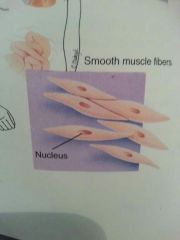
Also called smooth or visceral muscle
Cells are tapered at each end, have a single nucleus and they have a smooth even appearance Found in walls of hollow visceral structures such as digestive tract blood vessels and ureters Contractions are involuntary |
|
|
Function of the three major types of muscle tissues
|
All muscle cells specialize in contractions (shortening)
|
|
|
The microscopic structure
|
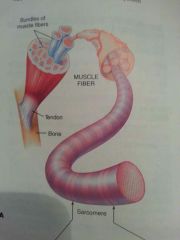
Contractile cells called fibers grouped into bundles
Fibers contain thick myofilaments (containing the protein myosin) and thin myofilaments (composed of actin) Basic functional (contractile) unit called sarcomere separated from each other by dark bands called Z lines Sliding filament model explains mechanism of contraction Thick and thin myofilaments slide past eachother as a muscle contracts Contraction requires calcium and energy rich ATP molecules |
|
|
The motor unit
|
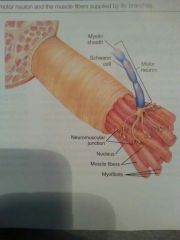
Stimulation of a muscle by a nerve impulse is required before a muscle can shorten and produce movement
A motor neuron is the specialized nerve that transmits an impulse to a muscle causing contraction A neuromuscular junction is the specialized point of cintact between a nerve ending and the muscle fiber it innervates Is the combination of a motor neuron with the muscle cell or cells it innervates |
|
|
Structure of skeletal muscle
|
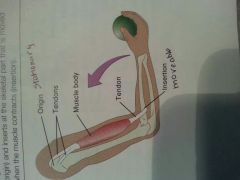
Each skeletal muscle is an organ composed mainly of skeletal muscle cells and connective tissue
Most skeletal muscles extend from one bone across a joint to another bone Muscels attach to bone by tendons some tendons enclosed in synovial lined tubes and are lubricated by synovial fluid tubes called tendon sheaths Bursae small synovial lined sacs containing a small of synovial fluid located between some tendons and underlying bones |
|
|
Parts of a skeletal muscle
|
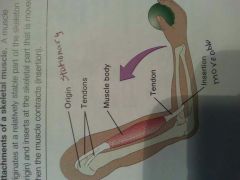
-Origin attachment to the bone that remains relatively strationary or fixed when movement at the joint occurs
-Intertion point of attachment to the bone that moves when a muscle contracts -Body main part of the muscle |
|
|
Functions of skeletal muscle: Movement
|
Prime mover muscles whose contraction is mainly responsible for producing a given movement
-Synergist muscle whose contractions help the prime mover produce a given movement -Antagonist muscle whose actions oppose the action of a prime mover in any given movement |
|
|
Functions of skeletal muscle: Posture
|
A specialized type of muscle contraction called tonic contraction enables us to maintain body position
In tonic contraction only a few of muscles fibers shorten at one time Tonic contraction produce no movement of baby parts |
|
|
Functions of skeletal muscle: Heat production
|
Survival depends of the bodys ability to maintain a constant body temperature
Contraction of muscle fibers produced most of the heat required to maintain normal body temperature |
|
|
Types of movement: Flexion
|
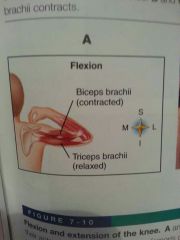
Movement that decreases the angle between two bones at their joints (bending)
|
|
|
Types of movement: Extension
|
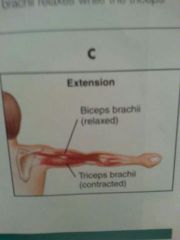
Movement that increases the angle between two bones at their point (straightening)
|
|
|
Types of movement: Abduction
|
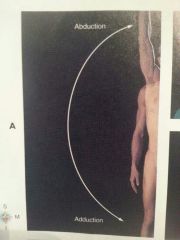
Movement of a part away from the midline of the body
|
|
|
Types of movement: Adduction
|
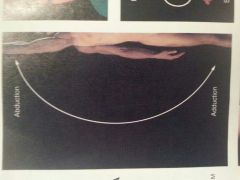
Movement of a part toward the midline of the body
|
|
|
Types of movement: Rotation
|
Movement around a longitudinal axis
|
|
|
Types of movement: Supination
|
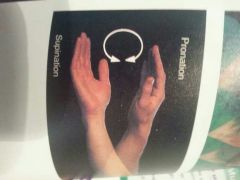
Hand positions that result from rotation of the forearm
Results in a hand position with the palm turned to the anterior position |
|
|
Types of movement: Pronation
|
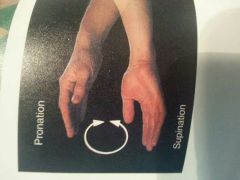
Occurs when the palm faces posteriorly
|
|
|
Types of movement: Dorsiflexion
|
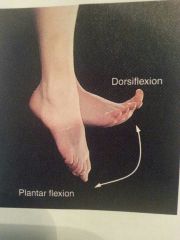
Results in elevation of the dorsum or top of the foot
|
|
|
Types of movement: Planter flexion
|
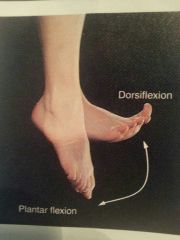
The bottom of the foot is directed downward
|
|
|
Is another name for muscle cell
|
Muscle fiber
|
|
|
Cardiac muscle makes up the bulk of this tissue of the
|
Heart
|
|
|
The muscle attachment to the more movable bone
|
Insertion
|
|
|
The muscle attachment to the more stationary bone
|
Origin
|
|
|
Is the protein that makes up the thin myofilaments
|
Actin
|
|
|
Is the protein that makes up the thick myofilaments
|
Myosin
|
|
|
The basic functional unit of contraction in a skeletal muscle
|
Sarcomere
|
|
|
The three functions of the skeletal system
|
Movement, posture, heat production
|
|
|
What molecule supplies energy for muscle contraction
|
ATP
|
|
|
Is the waste product produced when the muscle must switch to an energy supplying process that does not require oxygen
|
Lactic acid
|
|
|
A single motor neutron with all the muscle cells in innervates
|
Motor unit
|
|
|
Is the minimal level of stimulation required to cause a muscle fiber to contract
|
Threshold stimulus
|
|
|
A type of muscle contraction that produces movement in a joint and allows the muscle to shorten
|
Isotonic
|
|
|
A type of muscle contraction that does not produce movement and does not allow the muscle to shorten but increases muscle tension
|
Isometrie
|
|
|
A term describing movement of a body part away from the midline of the body
|
Abduction
|
|
|
A term used to describe the movement that is the opposite of flexion
|
Extension
|
|
|
Describes the hand position when the body is an anatomical position
|
Supination
|
|
|
Skeletal muscles can also be called
|
Voluntary muscle
|
|
|
Smooth muscles can also be called
|
Visceral, involuntary, nonstriated
|
|
|
Types of muscles in the head or neck
|
Temporal muscle, masseter, sternocleidomastoid, trapezius, zygomaticus, orbicularis oris, orbicularis oculi
|
|
|
Types of muscles that move the upper extremities
|
Pectoralis major, latissimus doris, deltoid, biceps branchii, triceps branchii
|
|
|
Types of muscles that are in the trunk
|
Rectus abdominis, external oblique, internal oblique, transversus abdominis, intercostal muscles, diaphragm
|
|
|
Types of muscles that move the lower extremities
|
Iliopsoas, gluteus maximus, adductor muscles, hamstring muscles, semimembranosus, senitendinosus, biceps femoris, quadriceps femoris, rectus femoris, vastus muscle, tibialis anterior, gastrocnemius, peroneus group
|

